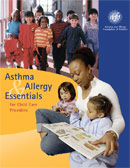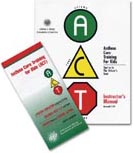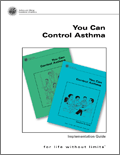The programs listed below are available through the national office of the Asthma & Allergy Foundation of America. To get information on prices and how to place an order, either log onto (or cut and paste the following link into your browser):
http://www.aafa.org/page/programs-for-patients-and-caregivers.aspx#freecall
OR
call 800-7-Asthma (1-800-727-8462) for details.
Available Monday – Friday, 10 a.m. – 3 p.m. ET.
Asthma & Allergy Essentials for Child Care Providers

Give child care providers the information they need to care for children with asthma and allergies. During this interactive 3-hour program, a trained health professional teaches providers how to recognize the signs and symptoms of asthma and allergies, how to institute environmental control and prevention measures, and how to use medications and tools to manage these diseases. This program was first developed in 1994 by the AAFA Maryland-Greater D.C. Chapter and reflects the current standards from the 1999 Pediatric Asthma Guide for Managing Asthma in Children. For more information or to set up an Essentials class in your area please contact the AAFA MD/Greater DC Chapter at 410-484-2054.
Asthma Care Training (ACT) for Kids

![]() ACT is an asthma education and self-management program designed for children ages 7 to 12 and their parents. The program is divided into three, 1.5-hour sessions in which the parents and children are taught in separate classrooms and then brought together at the end of each session to share their new knowledge. ACT teaches children to work in cooperation with their parents and health care professionals to improve their decision-making skills and self-management behaviors. This occurs through a series of interactive games and activities that teach children how to identify asthma-related symptoms, ways to communicate with adults, ways to avoid triggers, how to take preventive measures, and the appropriate use of medications.
ACT is an asthma education and self-management program designed for children ages 7 to 12 and their parents. The program is divided into three, 1.5-hour sessions in which the parents and children are taught in separate classrooms and then brought together at the end of each session to share their new knowledge. ACT teaches children to work in cooperation with their parents and health care professionals to improve their decision-making skills and self-management behaviors. This occurs through a series of interactive games and activities that teach children how to identify asthma-related symptoms, ways to communicate with adults, ways to avoid triggers, how to take preventive measures, and the appropriate use of medications.
Program Goals
The overall goal of the program is to reduce the frequency and severity of asthmatic episodes. Additional goals are to:
- Increase the childrens and parents knowledge of symptoms, causes, and treatment regimens
- Explore their attitudes and feelings about asthma and its treatment
- Improve their decision-making skills in preventing asthma episodes
- Encourage parents to permit and reinforce their childrens self-care behaviors
Program Outline
Session One: Warning Signals
- What asthma is and how it affects the body
- Recognizing and gauging the severity of symptoms
- Use of peak flow meters
- Decision-making about asthma-related issues
Session Two: Roadblocks
- Why asthma develops and what triggers it
- Asthma facts and fallacies
- Identifying personal asthma triggers and what to do to avoid them
- Peak flow practice
Session Three: Tune-Ups
- Medications
- Breathing exercises and relaxation techniques
- Program review
Program Materials
The ACT program kit includes:
- Three instructor manuals (one for the childrens instructor, one for the parents instructor and one for the physician/pharmacist to discuss asthma medications)
- Two instructor kits (reusable trigger and environmental picture panels, relaxation tape, etc.)
- Master copy of reproducible handouts for the parents and children
- One set of supplementary items for educating 10 families
- Telephone training on how to use the kit (for purchasers in the U.S.)
Preparation of Instructors
Instructors for this program should be health professionals such as nurses, respiratory therapists, physicians and pharmacists familiar with pediatric asthma management. A team of 2 – 3 instructors is needed to implement ACT (1 child instructor, 1 parent instructor, and 1 medication concepts instructor). Training of the ACT team of instructors is required and included in the purchase price of the program for U.S. purchasers. The 2-hour session is conducted by an AAFA trainer via a telephone conference call.
Program Development
ACT was developed by a group of physicians, nurses, and educators at UCLA School of Nursing in 1983 and is cited as a validated patient education resource in the 1997 National Asthma Education and Prevention Program (NAEPP) 1997 Expert Panel Report 2: Guidelines for the Diagnosis and Management of Asthma. The program was updated in 1994 and 1997 to adhere to NAEPP Guidelines for the Diagnosis and Management of Asthma. In 2003 the medication section of the program materials was updated to conform to the NAEPP Update on Selected Topics 2002.
Program Validation
For more details on the research validating the ACT program, reference the following two articles:
Lewis CD, Rachelefsky G, Lewis MA, de la Sota A, Kaplan M. A randomized trial of ACT (asthma care training) for kids. Pediatrics. 1984 Oct;74(4):478-86.
Rachelefsky GS, Lewis CE, de la Sota A, Lewis MA. ACT (asthma care training) for kids. A childhood asthma self-management program. Chest. 1985 Jan;87(1Suppl):98S-100S.
In addition, visit the following CDC website http://www.cdc.gov/asthma/interventions/children.htm#ACT Kids for a case study on how one site successfully replicated the program.
You Can Control Asthma

![]() You Can Control Asthma is a validated asthma education program designed to give children ages 6 to 12 and their families more self-confidence and the necessary knowledge and skills needed to control asthma. It consists of a set of parallel booklets for children and their parents, which teach principles of asthma management through pictures, captions, and activities. Also included is an Implementation Guide designed to provide successful strategies for educating families in clinical, community, school and home settings using the You Can Control Asthma booklets.
You Can Control Asthma is a validated asthma education program designed to give children ages 6 to 12 and their families more self-confidence and the necessary knowledge and skills needed to control asthma. It consists of a set of parallel booklets for children and their parents, which teach principles of asthma management through pictures, captions, and activities. Also included is an Implementation Guide designed to provide successful strategies for educating families in clinical, community, school and home settings using the You Can Control Asthma booklets.
These low-literacy, culturally appropriate booklets, available in English and Spanish, can be used alone or with the Implementation Guide in a formal educational program. The illustrations, messages, vocabulary and layout of the booklets have been extensively tested with children and adults who have reading limitations.
Program Goals
The purpose of this initiative is to educate children with asthma, ages 6 to 12, and their parents/guardians about managing asthma, coping with the challenges associated with asthma, and providing a healthy home environment.
Program Outline
The Implementation Guide includes lesson plans for 5 parent and 5 child modules covering the following topics:
- Module I Asthma and Asthma Attacks
- Module II Asthma Triggers
- Module III Peak Flow Meters
- Module IV Medicines
- Module V Decisions, School and Feelings
Instructor Preparation
The Implementation Guide provides information to prepare instructors. Instructors of the education sessions should be trained health professionals such as nurses, respiratory therapists, health educators, or social workers.
Program Development
The books for children and families were developed by a team of physicians, nurses, and health educators which included Georgetown Universitys Division of Childrens Health Promotion in the Department of Family Medicine. The Implementation Guide was created by AAFA by compiling the experiences of many organizations that have been using the books to educate children and parents in clinical, community, and school settings.
Program Validation
The You Can Control Asthma program was validated in 1991 and updated in 1997 to adhere to the National Asthma Education and Prevention Programs (NAEPP) Expert Panel Report 2: Guidelines for the Diagnosis and Management of Asthma. Program materials were updated again in 2004 to adhere to the NAEPP Update on Selected Topics 2002.
For more information on the research validating the effectiveness of this program see the following articles:
Taggart V.S., Zuckerman A. E., Sly M. R., Steinmueller C., et al. You Can Control Asthma: Evaluation of an Asthma Education Program for Hospitalized Inner-City Children. Patient Education and Counseling. 1991; 17: 35-47.
Taggart VS, Zuckerman AE, Lucas S, Acty-Lindsey A, Bellanti JA. Adapting a self-management education program for asthma for use in an outpatient clinic. Annals of Allergy. 1987 March, 58: 173-178.
Also visit the following CDC website http://www.cdc.gov/asthma/interventions/children.htm#control for a case study on how one site successfully implemented the program.
Power Breathing Program

![]() The Power Breathing Program provides a basic understanding of asthma and its management in a peer-friendly environment. It empowers and motivates adolescents, ages 11-19, to take control of their asthma on a personal level. Power Breathing is the only nationally available asthma education program on the market that acknowledges and addresses teens social and lifestyle concerns. View A Message to Parents Video
The Power Breathing Program provides a basic understanding of asthma and its management in a peer-friendly environment. It empowers and motivates adolescents, ages 11-19, to take control of their asthma on a personal level. Power Breathing is the only nationally available asthma education program on the market that acknowledges and addresses teens social and lifestyle concerns. View A Message to Parents Video
The program is presented in three 90-minute sessions or alternately six 45-minute sessions suitable for school settings. An additional fourth session is designed for older teens leaving home or entering the workforce. Each session includes hands-on instruction; discussion and strategic thinking; video animation; and Class Dismissed!a board game to test asthma knowledge.
Through the Power Breathing Program, teens learn that they have the power to control their asthma and not allow asthma to control them!
Program Goals
The Power Breathing Program is designed for teens to achieve each of the following goals:
- Describe the basic pathophysiology of asthma and the role of inflammation.
- State three triggers and irritants and measures to reduce or avoid them.
- Express personal wishes and hopes with the expectation that these life goals can be achieved in spite of their asthma.
- Develop constructive coping strategies to address concerns, fears, and barriers in asthma management.
- Use new communication skills in working with their asthma management team.
- Introduce peak flow monitoring into their asthma management plan.
- Identify classes of medications, how they work, and when they should be taken.
Program Outline
Session One: Basic Asthma Education
- How the body is affected.
- The role of inflammation.
- Triggers and irritants.
Session Two: Social and Emotional Issues of Asthma
- Fitting in without jeopardizing health.
- Family dynamics.
- Realistic and reassuring coping mechanisms.
Session Three: Asthma Treatment
- Myths and falsehoods.
- Medication overview.
- Peak flow monitoring.
Session Four:Transitions and Healthy Choices
- Leaving home.
- Entering the workforce.
- Changing health care providers.
- Dealing with peer pressure.
Program Materials
The Power Breathing Program kit includes:
- Youve Got the Power video (shown at the beginning of each session)
- Facilitator Handbook
- Implementation Guide
- Masters of reproducible handouts for teens and parents
- Two new videos: A Message to Parents and Facilitator Orientation (contains sessions 1-7 for facilitators self-study and for teens who miss a class)
- Class Dismissed! board game
Preparation of Facilitator
The Power Breathing Program Facilitator Handbook and Implementation Guide are designed for the preparation of new facilitators. These materials provide information on the characteristics, educational needs, and compliance issues unique to adolescents with asthma; strategies for communicating with adolescents; the goals and content of the Power Breathing Program; recruiting strategies; conducting a session; and follow-up activities.
Program Development
A diverse team of physicians, health educators, and teens worked with AAFA during the development phase to ensure the effectiveness of the Power Breathing Program. All sessions and materials adhere to the 1997 National Asthma Education and Prevention Programs (NAEPP) Expert Panel Report 2:Guidelines for the Diagnosis and Management of Asthma. In addition, the medication section was updated in 2004 to conform to the NAEPP Update on Selected Topics 2002.
Program Validation
Preliminary reports from the Research Triangle Institute indicate significant improvement on multiple measures including asthma knowledge, attitudes about asthma, asthma management behaviors, and quality of life. A full report on their recent research study validating the Power Breathing Program will be available soon. Moreover, the program has been referenced in the following article:
Berg J, Tichacek MJ, Theodorakis R. Evaluation of an educational program for adolescents with asthma. J Sch Nurs. 2004 Feb;20(1):29-35.
Wee Wheezers

![]() Wee Wheezers is a validated asthma education program in English and Spanish, based on social learning theory and designed specifically for parents of young children under the age of seven. The program consists of four small group sessions for parents that last approximately 2-hours each. Children, ages 4-6, attend two sessions designed for them along with their parents. Nurses with pediatric asthma management experience or other professional health education providers familiar with pediatric asthma facilitate the sessions.
Wee Wheezers is a validated asthma education program in English and Spanish, based on social learning theory and designed specifically for parents of young children under the age of seven. The program consists of four small group sessions for parents that last approximately 2-hours each. Children, ages 4-6, attend two sessions designed for them along with their parents. Nurses with pediatric asthma management experience or other professional health education providers familiar with pediatric asthma facilitate the sessions.
Program Goals
The program helps parents gain the knowledge, skills and motivation necessary to recognize, prevent, and/or appropriately manage asthma symptoms; to use medical, educational, and interpersonal resources for information and support; communicate effectively with other adult caretakers and physicians; and promote general well-being of the family unit. The program helps children learn basic asthma management skills.
Program Content
Parents
- Basic Concepts of Asthma
- Coping in Crisis
- Action Plan for Asthma Management
- Symptoms of an Acute Episode
- Feelings/Concerns
- Symptoms Prevention
- Communication about Asthma
Children
- Asthma physiology
- Early warning signs and triggers
- Belly breathing
- Asthma self-management
- Use of peak flow meters
- Use of metered dose inhalers
- Use of asthma medications
Program Materials
The Wee Wheezers program kit includes the following materials packaged in a convenient box with carrying handle for easy transport to your program site:
- Instructor Manual (includes a Program Implementation and Training Guide, Evaluation Guide, and Curriculum)
- Instructor Videotape (for classroom viewing)
- Companion Videotape (for at-home viewing)
- Masters of handouts for reproduction
- CD with handouts, visuals, and evaluation forms (PowerPoint and PDF formats)
Preparation of Instructors
Instructors for this program should be health professionals (i.e. nurses, respiratory therapists, nurse practitioners, etc.) or others who have:
- Interpersonal skills with both parents and young children;
- Pediatric asthma management knowledge and experience; and
- Group facilitation skills.
A Program Implementation and Training Guide is included with the program materials to prepare instructors for teaching the program.
Program Developer
Wee Wheezers was developed by a team of pediatric and pulmonary medicine specialists, psychologists, public health educators, and educational video specialists led by Dr. Sandra Wilson, Ph.D.
Program Validation
The results of the original research validating the effectiveness of this program indicate improvement on five outcome measures with statistically significant improvement in symptom-free days and sleep interruption. There were also significant gains in parental knowledge about asthma and asthma management.
For more details on the research validating the Wee Wheezers program, reference the following article:
Wilson SR, Latini D, Starr NJ, Fish L, Loes LM, Page A, Kubic P. Education of parents and infants and very young children with asthma: a developmental evaluation of the Wee Wheezers program. J Asthma. 1996;33(4):239-54
In addition, visit the following CDC website http://www.cdc.gov/asthma/interventions/children.htm#wee for a case study on how one site successfully replicated the program.
![]() This symbol indicates a validated health education program demonstrated through formal research to be an effective educational intervention.
This symbol indicates a validated health education program demonstrated through formal research to be an effective educational intervention.

